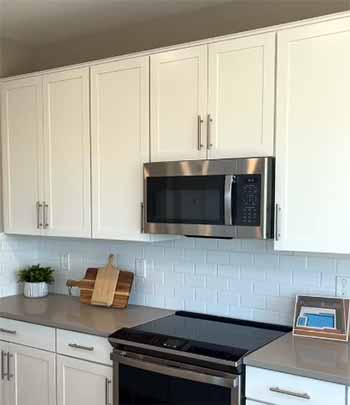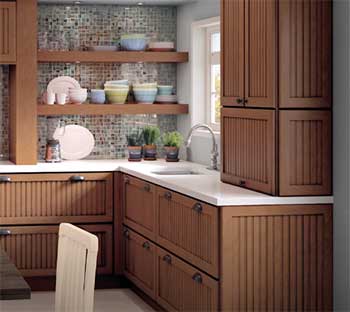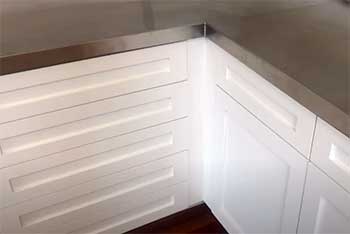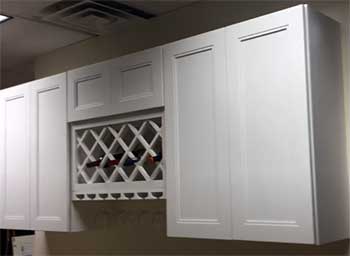Let me start by saying this: if you’re hunting for new kitchen or bathroom cabinets, you might stumble across Aristokraft Cabinets and think, “Hey, these could work!” I get it—on paper, they sound tempting with their affordable price tag and variety of styles.
But hold up before you hit that buy button.
After my own experience and hearing from others, I’m here to tell you why you might want to steer clear. Trust me, I’ve been through the wringer with these cabinets, and I’d hate for you to waste your money on something that could leave you frustrated—or worse, with a smashed finger like mine.
My Experience With Aristokraft Cabinets

Picture this: it’s 2019, and I’m moving into my brand-new home, giddy about the “designer” kitchen I’d been promised.
The real estate agent couldn’t stop raving about the upgraded Aristokraft Cabinets—sleek, modern, and supposedly built to last.
I was sold.
Fast forward a few months, and I’m standing in my kitchen, staring at a drawer front that’s just snapped off in my hand.
I wasn’t even yanking it hard—it just gave up, fell, and smashed my finger against the granite countertop. Ouch doesn’t even cover it.
At first, I thought it was a fluke. Maybe I got a dud drawer, right? Nope. Over the next year, the problems piled up like dirty dishes. The tracks on my drawers started wobbling, then outright failing, leaving me fishing pots and pans out of a collapsed mess.
The cabinet sides—made of what I now know is cheap particle board—began to loosen as the staples holding them together wiggled free. And don’t get me started on the peeling. The finish on these cabinets started flaking off like a bad sunburn, exposing raw, ugly wood underneath.
I tried contacting Aristokraft, but their warranty process sent me on a wild goose chase through distributors who couldn’t—or wouldn’t—help.
Five years in, and my kitchen looks like it’s been through a war zone. I’ve got peeling doors, misaligned drawers, and a sinking feeling that I’ll need to replace everything soon.
My grandmother’s 1960s cabinets—complete with minor termite damage—are holding up better than this “designer” nonsense. I spent good money expecting quality, not a DIY disaster. If I’d known then what I know now, I’d have run the other way.
Pros of Aristokraft Cabinets

Okay, I’ll give credit where it’s due—Aristokraft isn’t all bad. There are a few things they get right, even if my experience soured me on the whole deal. Let’s break it down.
- Affordable Price Point
One thing that drew me to Aristokraft in the first place was the cost. Compared to high-end brands like KraftMaid or custom local options, these cabinets won’t drain your bank account. If you’re on a tight budget—like I was when I bought my house—they can seem like a lifesaver.
You’re looking at a fraction of the price, sometimes thousands less, which leaves room for splurging on a fancy countertop or new appliances. For builders or folks flipping houses, that low price tag is a big selling point too. It’s just a shame the savings don’t hold up when you’re replacing parts a year later.
- Variety of Styles
I’ll admit, Aristokraft’s catalog had me drooling at first. They’ve got a ton of options—modern shaker doors, classic wood finishes, even thermofoil for a sleek look. Whether you’re into birch, maple, or a painted white vibe, they’ve got something that’ll catch your eye.
When I picked mine, I went for a white shaker style that looked sharp against my dark countertops. On day one, they were gorgeous. It’s the kind of variety that makes you think you’re getting a custom feel without the custom price. Too bad the looks didn’t last.
- Easy Availability
You won’t have to hunt these cabinets down. Aristokraft works through a network of authorized dealers, and big builders like Pulte Homes Group often use them as a standard or upgrade option. When my house was built, they were already part of the package—no special orders or long wait times.
That accessibility is a plus if you’re in a pinch or working with a contractor who’s already got them on speed dial. It’s convenient, sure, but convenience doesn’t mean much when the quality tanks.
- Lifetime Warranty on Hardware
Here’s a small bright spot: Aristokraft offers a lifetime warranty on their drawer guides and hinges. I haven’t had to test this yet—my issues were more about the cabinet bodies than the hardware—but it’s nice to know in theory.
If your hinges start squeaking or your drawers won’t glide, you might actually get some help. That said, good luck getting through their warranty process without pulling your hair out. Still, it’s a pro worth mentioning, even if it’s a small consolation.
Cons of Aristokraft Cabinets
Now, let’s get real. The downsides of Aristokraft Cabinets outweigh the perks by a mile—at least in my book. Here’s why I’m warning you off them.
- Poor Quality Materials

I can’t sugarcoat this: the materials are junk.
My cabinets are mostly particle board, not the sturdy plywood I’d been promised as part of my “upgrade.”
Particle board might be fine for a cheap bookshelf, but in a kitchen? Forget it.
It crumbles under pressure, warps with moisture, and doesn’t hold staples or screws worth a damn.
My drawer sides are proof—loose and wobbly after just a couple years.
And that thin finish? It peels off if you look at it funny.
I’ve scrubbed spots with mild soap and watched the paint vanish. This isn’t quality—it’s a shortcut that leaves you screwed.
- Shoddy Construction
The build quality is a nightmare. My drawers are held together with staples—staples!—that pop out like they’re auditioning for a horror movie. The track systems are flimsy, misaligned, and prone to collapsing.
I’ve lost count of how many times I’ve had to shove a drawer back onto its rails. And the doors? Some folks report frames falling apart, and I’ve seen edges chip off mine like they’re made of cardboard. For a company that’s been around since 1954, you’d think they’d have this figured out.
Nope. It’s slapdash work that falls apart faster than you can say “warranty claim.”
- Terrible Durability
If you’re hoping these cabinets will last a decade, think again. Mine started peeling within two years, and by year five, they were a wreck. I’ve heard the same from others—finishes flaking off in six months, doors warping near the stove, drawers failing under normal use.
I don’t have kids or pets roughing them up; this is just me cooking dinner and expecting things to hold together. Compare that to my grandma’s ancient cabinets, still kicking after 60 years, and it’s laughable. Aristokraft’s stuff doesn’t stand the test of time—it barely survives a lease.
- Awful Customer Service and Warranty Woes
Oh, the warranty. They tout a five-year limited warranty on the cabinets and a lifetime one on hardware, but good luck cashing in. When my cabinets started peeling and breaking, I called Aristokraft, only to be bounced to a distributor who shrugged and said, “Not our problem.”
Three years of back-and-forth with my builder and local reps got me nowhere. The process is vague, the support is nonexistent, and they’ll blame you for “normal wear and tear” faster than you can blink. Five years isn’t even a long warranty—most brands offer lifetime coverage.
This is a company that hides behind fine print and leaves you high and dry.
Maintenance Tips For Aristokraft Cabinets
If you’ve already got Aristokraft Cabinets—or you’re stuck with them like I was—here’s how to keep them from falling apart faster than they already might. Trust me, I’ve learned these the hard way.
- Clean Gently and Sparingly
That thin finish I keep complaining about? It’s fragile as heck. I made the mistake of scrubbing a grease spot with a sponge and mild soap, and the paint washed right off. Stick to a damp cloth—barely wet—and a tiny dab of dish soap if you must.
Wipe, don’t scrub, and dry it immediately. Harsh cleaners or abrasive pads will wreck the surface in no time. It’s a pain, but it might buy you a few extra months before the peeling starts.
- Avoid Moisture Like the Plague
Particle board and moisture are a match made in hell. I noticed my cabinets near the sink and stove took the biggest hit—warping and peeling galore. Keep them dry at all costs.
Wipe up spills right away, use a dehumidifier if your kitchen’s steamy, and maybe even slap some sealant on the edges if you’re handy. It won’t fix the core problem, but it’ll slow the damage. Trust me, you don’t want to see what mine look like now.
- Reinforce Those Tracks
The drawer tracks are a weak link—mine failed spectacularly. If yours start wobbling, don’t wait for the crash. Grab a screwdriver and tighten any loose screws you can find.
If you’re feeling ambitious, swap out the cheap rails for sturdier aftermarket ones. I didn’t do this in time, and I regret it every time I’m prying a skillet out of a fallen drawer. It’s not a perfect fix, but it beats the alternative.
- Handle with Kid Gloves
These cabinets can’t take a beating. I learned to open drawers and doors like I’m handling fine china—slowly, gently, no yanking. Overloading them is a death sentence too. Keep the weight light—don’t stack heavy pots or cram in extra cans.
It’s annoying to baby them, but it’s the only way to stretch their pitiful lifespan. I wish I’d known this before my finger met the countertop.
Comparison of Aristokraft Cabinets With Other Brands
Alright, let’s put Aristokraft Cabinets in the ring with some other contenders—Cardell Cabinets, Barker Cabinets, and 21st Century Cabinets. I’ve been stuck with Aristokraft’s mess long enough to know what I wish I’d chosen instead.
Here’s how they stack up, head-to-head, so you can see why I’d tell you to dodge Aristokraft and pick a better fighter.
- Aristokraft Vs. Cardell Cabinets

Cardell Cabinets feel like Aristokraft’s older sibling who actually got their act together.
While my Aristokraft cabinets are peeling and falling apart thanks to particle board and staples, Cardell steps up with more solid options—think plywood boxes and real wood doors in their higher-end lines.
I’ve seen Cardell kitchens last a decade without the finish flaking off like mine did in two years.
They’re pricier, sure, but not crazy—maybe a grand more for a full set. Aristokraft’s cheap upfront cost lured me in, but Cardell’s durability would’ve saved me the replacement headache.
Plus, Cardell’s warranty isn’t a maze of excuses like Aristokraft’s.
- Aristokraft Vs. Barker Cabinets

Barker Cabinets are the DIY champ Aristokraft could only dream of being.
These guys ship ready-to-assemble cabinets straight to your door, and they’re all about quality—plywood construction, dovetail drawers, the works.
My Aristokraft drawers collapsed under a stack of plates, but Barker’s sturdy builds laugh at heavy loads.
I love that Barker lets you customize sizes and finishes without breaking the bank—Aristokraft’s “variety” feels rigid in comparison.
Barker’s pricing sits a bit above Aristokraft, but you’re paying for cabinets that won’t leave you cursing in your kitchen five years later. I’d take Barker’s reliability over Aristokraft’s flimsy gamble any day.
- Aristokraft Vs. 21st Century Cabinets

Then there’s 21st Century Cabinets, a sleeper hit that makes Aristokraft look like it’s stuck in the last century.
These cabinets come with solid wood fronts and plywood sides as standard—not the particle board junk I got stuck with.
My Aristokraft finish washed off with a sponge, but 21st Century’s thicker coatings shrug off wear and tear.
They’re budget-friendly too, often matching or beating Aristokraft’s price while delivering way more bang for your buck.
I’ve heard their customer service actually picks up the phone—unlike Aristokraft’s ghosting game. If I could rewind, I’d pick 21st Century’s solid value over Aristokraft’s false promises in a heartbeat.
So, there you have it—Aristokraft versus the competition. It’s like pitting a rickety scooter against a lineup of sleek motorcycles. Cardell brings the durability, Barker offers custom quality, and 21st Century delivers value that Aristokraft can’t touch.
I fell for Aristokraft’s low price and pretty styles, but the peeling, the breaking, the frustration—it’s not worth it. You’ve got better options out there, trust me.
Frequently Asked Questions (FAQ)
Yes and no—it depends. Aristokraft offers a range, from basic builder-grade stuff to “upgraded” lines like mine were supposed to be. Builder grade typically means cheap particle board and minimal frills, which fits a lot of their stock. My “designer” cabinets were pitched as a step up, but they’re still particle board junk, so don’t let the labels fool you. Check the specs with your builder—most of what I’ve seen leans toward low-end.
Mostly particle board, at least in my experience. The sides, backs, and shelves are that pressed-wood stuff that falls apart fast. Doors might be solid wood or thermofoil—a vinyl layer over particle board—but don’t expect all-plywood construction unless you fight for an upgrade. Some hardware’s decent, but the core materials? Cheap and flimsy. That’s why mine are peeling and collapsing.
Five years limited on the cabinets themselves—covers defects in materials or workmanship, supposedly. Drawers, guides, and hinges get a lifetime warranty, which sounds great until you try to use it. My peeling doors and busted drawers didn’t qualify, and the process was a mess. Five years is stingy compared to lifetime warranties from KraftMaid or IKEA’s 25 years. Good luck getting help either way.
Not by default. Some models—like my “upgraded” ones—can come with soft-close drawers if you pay extra or your builder specs it. Mine were promised as soft close, but the tracks are so bad they barely function, soft or not. It’s an option, not a standard, so double-check before you buy. Even then, the quality’s so shaky I wouldn’t bank on it.
Wrapping Up
Look, I’ve been burned by Aristokraft Cabinets, and I don’t want you to be next. They might lure you in with low prices and pretty styles, but the reality—peeling finishes, crumbling particle board, and nonexistent support—is a nightmare. Save yourself the headache and skip these.
Whether it’s KraftMaid’s durability, IKEA’s value, or Fabuwood’s quality, there are better options out there. Trust me, your kitchen deserves more than what Aristokraft’s serving up.
